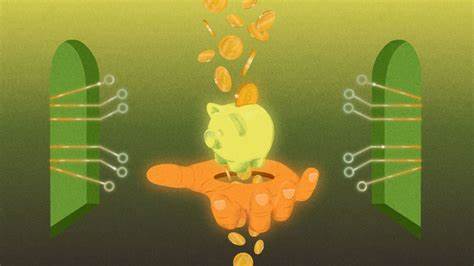The landscape of digital currencies has evolved significantly, introducing various forms of value storage and exchange mechanisms. Among these innovations are particular types of digital assets designed to maintain a stable value by linking themselves to traditional currencies or commodities. These instruments play a crucial role in mitigating volatility, making them appealing for diverse applications in the financial realm.
In a context where unpredictability often reigns supreme, these stable assets serve as a bridge between the traditional financial world and the burgeoning digital marketplace. They offer users an opportunity to engage in transactions and investments with a reduced risk profile, thereby fostering greater confidence among participants. By anchoring their value to established financial entities, these digital tools strive to combine the benefits of technology with the stability of traditional currencies.
However, navigating this domain is not without its challenges. While these stable assets promise reliability, the mechanisms that underpin their value can introduce complexities that warrant careful examination. Investors and users alike must be aware of the inherent challenges and potential pitfalls associated with these innovative financial instruments. A deeper exploration into their structure and implications reveals the nuanced interplay between digital innovation and market stability.
What is Pegged Cryptocurrency?
This type of digital asset is designed to maintain a stable value by being linked to a specific reference asset. The underlying principle is to provide a reliable medium of exchange that mitigates the volatility often associated with traditional digital currencies. By tying its worth to a stable asset, such as a fiat currency or commodity, this financial instrument aims to offer users a sense of security and predictability in their transactions.
Characteristics of Stable Digital Assets
These currencies typically exhibit several defining features that distinguish them from more volatile variants. Some of the notable characteristics include:
| Feature | Description |
|---|---|
| Price Stability | Remains close to the value of the underlying asset, minimizing drastic price shifts. |
| Liquidity | Easily tradeable in various markets, enabling quick conversions to traditional currencies or other assets. |
| Transparency | Transactions are recorded on a public ledger, ensuring traceability and security. |
| Decentralization | Often built on blockchain technology, promoting a distributed and tamper-resistant nature. |
Common Types of Stable Digital Assets
Among the various iterations available in the market, some of the most recognized forms include:
- Fiat-collateralized – Backed by tangible assets like USD or EUR.
- Crypto-collateralized – Pegged to other digital currencies, usually held in smart contracts.
- Algorithmic – Use complex algorithms to manage supply based on demand, without direct backing.
Mechanisms Behind Pegged Tokens
The functioning of tokens tied to a particular asset or currency relies on specific mechanisms aimed at maintaining their value consistency. These mechanisms are designed to ensure that the token remains linked to its target asset, providing stability and predictability in an often volatile market. Understanding these underlying processes is essential for anyone looking to engage with such digital assets.
Collateralization
One common approach involves collateralization, where digital tokens are backed by a reserve of assets. This reserve can take various forms, such as fiat currency, commodities, or even other cryptocurrencies. The value of the token is maintained by ensuring that there is sufficient collateral held in reserve to cover its issuance, allowing for immediate conversion when necessary.
Algorithmic Adjustments
Another method employs algorithmic mechanisms that automatically adjust the supply of the token in response to market demands. By increasing or decreasing the availability of the token based on price fluctuations, these systems strive to keep the token’s value in line with its target. This approach often relies on smart contracts and advanced technology to execute changes efficiently and transparently.
Benefits of Using Pegged Assets
Utilizing assets linked to stable values offers several advantages that appeal to both investors and everyday users. These financial instruments provide a reliable means to minimize volatility, enhance transactional efficiency, and facilitate seamless access to various financial ecosystems.
Stability in Value
One of the most significant advantages of linked assets is their relative price stability. By anchoring their worth to an underlying currency or commodity, these instruments allow investors to avoid the dramatic fluctuations often seen in more volatile markets. This predictability makes them attractive for individuals looking to preserve capital during uncertain economic times.
Ease of Transaction
Assets tied to stable values can enhance transaction efficiency. With lower levels of volatility, users can confidently engage in buying, selling, or trading without the constant worry of impending price changes. This ease facilitates smoother commerce, allowing businesses to operate more effectively while gaining access to a broader audience. Furthermore, the streamlined process often results in reduced transaction costs, furthering the appeal for both consumers and merchants.
Potential Risks and Challenges
The landscape of stable digital currencies is not without its hurdles. Participants must remain vigilant regarding various potential pitfalls that can affect their value stability and overall functionality.
- Market Volatility: Although designed to maintain a stable value, external market pressures can lead to significant fluctuations.
- Counterparty Risks: Reliance on third-party entities for backing or redemption can expose users to financial instability and trust issues.
- Regulatory Uncertainty: As authorities continue to develop frameworks for digital assets, changes in regulations may impact operations.
- Technical Vulnerabilities: Smart contracts and platforms can be susceptible to bugs, exploits, or hacks that compromise assets.
- Liquidity Challenges: In certain scenarios, the ability to exchange stablecoins for fiat or other assets may diminish, leading to liquidity shortages.
Understanding these challenges is crucial for anyone considering involvement in this complex ecosystem, as they can significantly affect investment strategies and long-term sustainability.
Examples of Popular Pegged Cryptos
This section delves into notable digital currencies that maintain a stable value by being linked to traditional assets or currencies. These stable assets play a pivotal role in the broader financial ecosystem, providing users with alternatives that can mitigate volatility often associated with other virtual currencies.
Top Examples
| Name | Linked Asset | Market Cap |
|---|---|---|
| Tether (USDT) | U.S. Dollar | $68 billion |
| USD Coin (USDC) | U.S. Dollar | $27 billion |
| Dai (DAI) | U.S. Dollar | $6 billion |
| Binance USD (BUSD) | U.S. Dollar | $15 billion |
| TrueUSD (TUSD) | U.S. Dollar | $1 billion |
Characteristics of Stablecoins
The digital currencies listed above are designed to offer price stability by retaining an equal value to the underlying asset to which they are tethered. Users often utilize them for transactions or as a means to preserve value during turbulent market conditions.
How to Choose a Pegged Asset
Selecting an asset tied to a specific value requires careful consideration of various factors to ensure it aligns with your financial objectives and risk tolerance. The choice should reflect both stability and liquidity, as these elements are crucial for effective management and investment potential.
Here are some key criteria to evaluate when assessing a suitable asset:
| Criteria | Description |
|---|---|
| Liquidity | Ensure the asset can be easily bought or sold without significant price fluctuations. |
| Stability | Look for assets that maintain a consistent value over time, minimizing exposure to extreme volatility. |
| Backing | Assess the reserve mechanisms supporting the asset, such as fiat currencies or commodities. |
| Regulatory Compliance | Confirm that the asset adheres to legal standards and regulations within your jurisdiction. |
| User Adoption | Consider the level of acceptance and usage within the market, as higher adoption can lead to greater stability. |
By examining these aspects thoroughly, investors can make informed decisions and select an asset that meets their needs while mitigating potential downsides.
Q&A: What does pegging mean in crypto how pegged crypto works and related risks
What is pegged crypto, and how does it differ from standard cryptocurrencies?
Pegged crypto, or pegged stablecoins, are cryptocurrencies designed to maintain a stable value by being tied to a reserve asset, such as a fiat currency (like the US dollar) or commodities (like gold). Unlike standard cryptocurrencies like Bitcoin or Ethereum, which can exhibit significant price volatility, pegged cryptocurrencies aim to provide a more stable digital asset for transactions and savings. This stability is achieved through mechanisms that ensure the supply of the pegged crypto can be adjusted in response to demand, maintaining its value relative to the asset it is pegged to.
How does a pegged cryptocurrency maintain its value over time?
Pegged cryptocurrencies maintain their value through a process known as “collateralization”. If a stablecoin is pegged to the US dollar, for instance, for every stablecoin issued, there would ideally be an equivalent amount of US dollars held in reserve. If the price of the stablecoin begins to rise above one dollar, users can redeem their stablecoins for dollars, thereby increasing supply and driving the price down. Conversely, if the price dips below one dollar, the system incentivizes buying back the stablecoin to reduce supply, which helps stabilize its price. Various algorithms and decentralized mechanisms can also be used to manage these adjustments, particularly with algorithmic stablecoins.
What are the risks associated with using pegged cryptocurrencies?
While pegged cryptocurrencies offer more stability than traditional cryptocurrencies, they are not without risks. One major risk involves the reliability of the underlying reserve assets. If the reserves backing a stablecoin are not sufficient or are poorly managed, it can lead to a loss of confidence and a potential devaluation of the pegged currency. Additionally, regulatory scrutiny is increasing, which could impact the availability and use of pegged cryptos in the future. There’s also the risk of smart contract vulnerabilities if the pegged cryptocurrency operates on a blockchain platform. Lastly, market dynamics can lead to scenarios where users may panic-sell their holdings, further leading to instability.
Can you give examples of popular pegged cryptocurrencies?
Some of the most well-known pegged cryptocurrencies include Tether (USDT), which is pegged to the US dollar, and USD Coin (USDC), which is also backed by the US dollar on a 1:1 basis. Another example is DAI, an algorithmic stablecoin that is pegged to the US dollar but is backed by a basket of cryptocurrencies rather than fiat reserves. Each of these stablecoins has different mechanisms and governance structures that help maintain their pegs. USDT, for instance, relies on central reserves and auditing, while DAI operates through over-collateralization and a decentralized governance model.
What role do pegged cryptocurrencies play in the wider cryptocurrency ecosystem?
Pegged cryptocurrencies play a crucial role in the broader cryptocurrency ecosystem by providing a stable medium of exchange and a safe haven during periods of high volatility. They facilitate trading on exchanges by serving as a liquidity pair, allowing traders to move funds in and out of more volatile cryptocurrencies with relative ease. Furthermore, pegged cryptos are commonly used in decentralized finance (DeFi) platforms for lending, borrowing, and yield farming, allowing users to earn interest without the risks associated with fluctuating asset values. Additionally, they can help onboard new users to the cryptocurrency space by providing a less volatile entry point for transactions or investments.
What is pegged cryptocurrency and how does it work?
Pegged cryptocurrency refers to digital assets that are tied to the value of a stable asset, such as a fiat currency or commodity. This means that for every unit of the pegged cryptocurrency, there is an equivalent value held in reserve to back it. The primary mechanism for maintaining this peg is through smart contracts, which automatically adjust the supply of the cryptocurrency based on the demand to keep its price stable. For example, if a pegged cryptocurrency is linked to the US dollar, the issuer will hold a corresponding amount of USD in reserve for every token issued. This system aims to provide the benefits of cryptocurrency, like fast transactions and security, while minimizing the volatility commonly associated with digital currencies.
What are the risks associated with pegged cryptocurrencies?
While pegged cryptocurrencies offer stability, they are not without risks. One significant risk is the potential for the reserves backing the peg to be insufficient or mismanaged. If the issuer does not hold enough assets to cover their cryptocurrency in circulation, it could lead to a loss of confidence and a subsequent drop in value. Additionally, the mechanisms used to maintain the peg can be vulnerable to market manipulation or technical failures. Regulatory risks also exist, as governments may impose new regulations that impact the operational framework of pegged cryptocurrencies. Lastly, there’s the inherent risk of any cryptocurrency, including security vulnerabilities or hacks, which can compromise user funds. Therefore, while a pegged cryptocurrency may offer more stability than other cryptocurrencies, it is essential for investors to conduct thorough research and understand these risks before getting involved.
How does a hard peg differ from a soft peg in the context of a country’s currency?
A hard peg is a strict and fixed exchange rate system where a country’s currency is tightly linked to a reserve currency like the U.S. dollar or a commodity such as gold, with minimal fluctuation. In contrast, a soft peg allows for some flexibility, where the currency’s value can fluctuate within a certain range or band around the pegged value. The central bank may intervene to maintain this range, but the currency is not as rigidly fixed as in a hard peg. This distinction is important in understanding how different countries manage their exchange rates and economic stability.
What does pegging refer to in the crypto world, and how does it impact the value of a cryptocurrency?
In the crypto world, pegging refers to the process of linking the value of a cryptocurrency to a stable currency, fiat money, or a commodity like gold. This pegging mechanism is commonly used in stablecoins, which are designed to maintain a stable value by being pegged to the dollar or another reserve currency. The value of the cryptocurrency is kept stable through various means, such as holding reserves of the pegged asset or using algorithms to adjust the supply. Pegging helps reduce volatility in the cryptocurrency market, making these assets more predictable and reliable for investors and users.
How do stablecoins maintain their value when pegged to a fiat currency or a commodity?
Stablecoins maintain their value by being pegged to a fiat currency, such as the U.S. dollar, or a commodity like gold. This pegging mechanism ensures that the value of the stablecoin remains stable relative to the asset they are pegged to. For instance, a stablecoin pegged to the dollar will hold reserves of U.S. dollars or dollar-denominated assets to back its value. In some cases, algorithms or smart contracts are used to manage the supply and demand of the stablecoin, ensuring that it remains close to its pegged value, even in fluctuating market conditions.
Why is the pegged value of a stablecoin important for crypto investors?
The pegged value of a stablecoin is crucial for crypto investors because it provides a stable and predictable asset in an otherwise volatile cryptocurrency market. Stablecoins pegged to the U.S. dollar or other reserve currencies offer a safe haven for investors to park their funds without worrying about significant fluctuations in value. This stability allows investors to trade between volatile crypto assets and stablecoins, helping them manage risk and maintain liquidity. The pegged value also facilitates easier transactions and cross-border payments within the crypto space, as the value remains consistent relative to fiat currencies.
How does pegging in crypto work, particularly for stablecoins pegged to the dollar?
Pegging in crypto, particularly for stablecoins pegged to the dollar, works by linking the value of the stablecoin to the U.S. dollar through various mechanisms. One common approach is to hold reserves of U.S. dollars or dollar-denominated assets equal to the circulating supply of the stablecoin. This ensures that each stablecoin can be redeemed for a corresponding amount of dollars, maintaining its pegged value. Some stablecoins use algorithms to adjust the supply based on demand, while others are backed by a combination of fiat currency, cryptocurrencies, or commodities. The pegging mechanism is essential for maintaining the stability and trustworthiness of these stablecoins in the cryptocurrency market.
What are the advantages of a cryptocurrency pegged to USD in the cryptocurrency market?
A cryptocurrency pegged to USD offers several advantages in the cryptocurrency market, including reduced volatility, increased trust, and broader acceptance for transactions. By being pegged to the dollar, the cryptocurrency maintains a stable value, which is crucial for users and investors who seek a predictable asset in the volatile crypto market. This stability also makes the cryptocurrency more suitable for everyday transactions, cross-border payments, and as a store of value. Additionally, the pegging to USD can enhance the credibility of the cryptocurrency, attracting more users and investors who prefer dealing with assets tied to a widely recognized and stable fiat currency.
How does a stablecoin pegged to the dollar compare to the gold standard in terms of maintaining value?
A stablecoin pegged to the dollar and the gold standard both aim to maintain value by linking the currency to a stable asset. However, while a stablecoin is directly pegged to the U.S. dollar, the gold standard involves pegging a currency to a fixed quantity of gold. Under the gold standard, the currency’s value is tied to the value of gold, which can fluctuate based on supply and demand in the gold market. In contrast, a stablecoin pegged to the dollar maintains its value relative to the dollar, which is generally more stable and widely accepted. The choice between a dollar-pegged stablecoin and the gold standard depends on the desired stability and the underlying asset’s reliability.
What role does a central bank play in maintaining a currency peg?
A central bank plays a crucial role in maintaining a currency peg by intervening in the foreign exchange market to keep the country’s currency aligned with the pegged value. This intervention may involve buying or selling foreign currency reserves, adjusting interest rates, or implementing monetary policies to stabilize the exchange rate. For instance, if a country’s currency is pegged to the U.S. dollar, the central bank will monitor the exchange rate closely and take action to prevent significant deviations from the pegged value. The central bank’s efforts ensure that the currency remains stable, promoting economic stability and investor confidence.
How do crypto-backed stablecoins differ from fiat-backed stablecoins in terms of pegging?
Crypto-backed stablecoins differ from fiat-backed stablecoins in terms of the asset used for pegging. While fiat-backed stablecoins are pegged to a fiat currency like the U.S. dollar, crypto-backed stablecoins are pegged to a basket of crypto assets or a specific cryptocurrency. For example, a crypto-backed stablecoin might be pegged to a combination of Bitcoin and Ethereum, with smart contracts managing the collateral to maintain the stablecoin’s value. This approach adds a layer of decentralization and allows the stablecoin to operate within the crypto ecosystem without relying on traditional banking systems. However, it also introduces additional risks, such as the volatility of the underlying crypto assets.
Why is the concept of pegging a cryptocurrency to another asset important in the crypto space?
The concept of pegging a cryptocurrency to another asset is important in the crypto space because it provides stability and predictability in a market known for its high volatility. By pegging a cryptocurrency to a stable asset, such as a fiat currency, commodity, or another cryptocurrency, the value of the pegged cryptocurrency remains relatively stable. This stability is essential for users who need a reliable medium of exchange, store of value, or unit of account within the crypto market. Pegging also facilitates the integration of cryptocurrencies into traditional financial systems, making them more accessible and trustworthy for a broader audience.
How do stablecoins and pegged cryptocurrencies affect the broader cryptocurrency market?
Stablecoins and pegged cryptocurrencies affect the broader cryptocurrency market by providing a stable alternative to volatile crypto assets, enhancing liquidity, and facilitating transactions. These assets offer a reliable store of value and medium of exchange, making them attractive for both traders and everyday users. In times of market turbulence, investors often move their funds into stablecoins to preserve value, which can influence market dynamics and trading volumes. Additionally, pegged cryptocurrencies enable easier cross-border payments and integration with traditional financial systems, expanding the use cases and adoption of cryptocurrencies in the global economy.
What is the significance of the pegging mechanism in maintaining the value of a cryptocurrency?
The pegging mechanism is significant in maintaining the value of a cryptocurrency because it ensures that the cryptocurrency remains stable relative to the asset it is pegged to. This stability is achieved through various methods, such as holding reserves, using smart contracts, or adjusting the supply based on demand. The pegging mechanism prevents significant fluctuations in the cryptocurrency’s value, making it more reliable for transactions, investments, and as a store of value. In the context of stablecoins, the pegging mechanism is critical for maintaining trust and confidence among users, as it guarantees that the stablecoin will consistently reflect the value of the pegged asset.
How does the pegged value of stablecoins impact their use in cryptocurrency exchanges?
The pegged value of stablecoins impacts their use in cryptocurrency exchanges by providing a stable trading pair for volatile crypto assets. On cryptocurrency exchanges, stablecoins pegged to fiat currencies, like the U.S. dollar, are often used as a safe haven during market downturns or to lock in profits without converting to traditional fiat money. This pegged value ensures that stablecoins can be easily exchanged for other cryptocurrencies or used for transactions without the risk of significant price changes. The stability of pegged stablecoins also enhances liquidity on exchanges, making them a vital component of the trading ecosystem in the crypto market.








